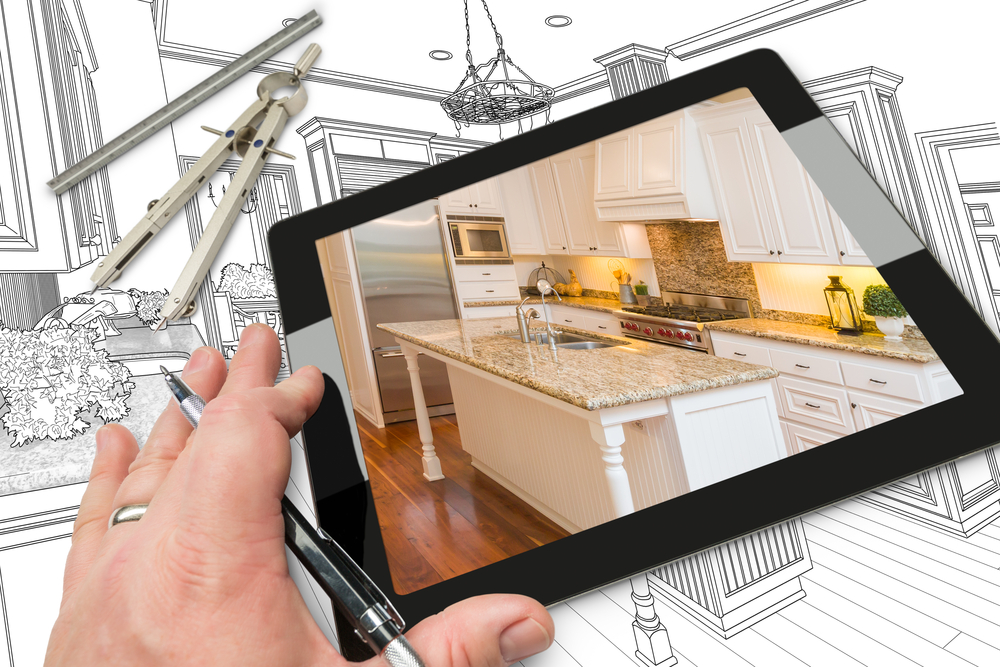
If you make custom cabinets, you know that good quality and proper fit are only part of the equation. Increasingly, customers are expecting an exceptional cabinet design and ordering experience. From kitchen cabinets, bathroom vanities, and custom built-ins to modular office furniture and store fixtures, it’s all about making your customer happy.
These days, it’s not enough to deliver outstanding craftsmanship at a reasonable price. You also need to offer an exceptional design experience to your customers. They want to feel in control of all the adjustments and options to truly create their ideal — and unique — product.
In today’s fast-paced world, customers expect a seamless and efficient process from the initial design to the finished product. That’s where integrating a cabinet design tool with your manufacturing ERP (Enterprise Resource Planning) system comes into play.
In this blog post, we’ll discuss using a web-based online kitchen cabinet design tool with your manufacturing ERP. Connecting the two will help you improve operations while giving your customers a better design experience.
Why Cabinet Design Tools Matter
Before we dive into the integration process, let’s discuss why a cabinet design tool is crucial for your business. In today’s digital age, customers want the ability to visualize their dream cabinets, make real-time changes, and see how it all fits together. A cabinet design tool allows you to offer this immersive experience, giving your customers a sense of control and personalization.
Additionally, these cabinet-building software solutions often come with features like 3D model rendering and the use of virtual reality. Customers can see and sometimes even feel like they are walking into their newly designed space. The beauty of this is reducing the risk of design errors by ensuring that the final product meets the customer’s expectations. This not only saves time and reduces scrap but also enhances customer satisfaction.
Choosing the right user-friendly software for kitchen cabinet design is a critical decision for custom cabinet manufacturers. It can significantly impact the efficiency of your operations, the quality of your products, and your ability to meet customer demands. Here are some important considerations to keep in mind when selecting a cabinet design tool to work with your manufacturing ERP software:
3 Benefits of Integrating a Cabinet Design Tool with Your Manufacturing ERP
1. Seamless Data Flow
Integrating your front-end cabinet design tool with your ERP system ensures a smooth flow of data. As customers design their cabinets, your ERP should automatically receive all the important details like materials, measurements, and finishes. This eliminates the need for manual data entry, reducing the risk of errors and saving valuable time.
2. Streamlined Production
With accurate design and order data at your fingertips, your cabinet manufacturing process becomes more efficient. Your team can easily create work orders, use materials efficiently, and schedule production confidently, knowing the designs match your manufacturing abilities.
3. Enhanced Customer Experience
Imagine providing your customers with the ability to track the progress of their cabinet orders in real-time. An integrated ERP system can make this a reality. Customers can receive updates on production milestones, and delivery dates, and even make modifications to their orders with ease. This level of transparency and flexibility goes a long way in building trust and satisfaction.
Your online cabinet design software needs to fully integrate with your manufacturing ERP software to make this happen. If you are not ready for that level of integration, consider a bolt-on 3d design tool. There are still many advantages to connecting cabinet design software with your manufacturing software.
Selecting a Cabinet Design Tool
Here are the key things to look for when evaluating a web-based cabinet design tool for your cabinet-building business:
Compatibility with Your Manufacturing ERP

With Frontier CADFlow, you can integrate your 3D drawings and designs created with your cabinet design tool with ease.
- Consider how well the software aligns and integrates with your manufacturing ERP software. Does it support the type of cabinets you produce, whether they are custom, semi-custom, or standard designs?
- Ensure the software can handle the various materials and construction methods you use in your cabinet production. For example, can it support both frame and frameless cabinets?
- Do you have a straightforward way to transfer the data into your ERP? This is a critical step in the process. Orders will need to be checked against your raw materials inventory, production line schedules, and more. Any errors from having to manually re-enter an order can be costly.
Ease of Use
- A user-friendly user interface is crucial. Your users should be able to quickly learn and use the software effectively to create 3d renderings of their custom products.
- Look for intuitive interfaces and online FAQs, training videos, and other support resources from the design tool to minimize your team’s involvement.
Design Capabilities
- Evaluate the software’s design features. Can it create complex cabinet designs with multiple configurations, including different styles, finishes, and hardware?
- Consider 3D visualization capabilities, as these enhance the customer experience by allowing them to see realistic representations of their designs.
Customization Options
- Every cabinet manufacturer has unique requirements. Ensure the software allows for customization to adapt to your specific needs and manufacturing processes.
- Look for the ability to create and save custom templates and design libraries. Some tools will allow you to upload your entire catalog and display your company logo on the ordering screen. Be careful that your online catalog doesn’t become outdated in terms of products and prices.
Integration with ERP and Production Systems
- Seamless integration with your manufacturing ERP system is vital. This ensures that design data flows smoothly into the production process.
- Check if the design software offers APIs or connectors for easy integration with your existing manufacturing systems. ERP software for custom cabinet manufacturing like Frontier will accept everything from .csv and flat files to .xml and EDI.
- Read more about different ways to integrate design tools in this blog post, Crafting Efficiency: 3 Ways to Connect Cabinet Design Software to Manufacturing
Material Optimization
- Does your cabinet design tool include features for optimizing material usage? This can help reduce waste and save costs.
- Cutting optimization tools will generate efficient cutting plans for your materials. If the design software doesn’t include this detail, ensure your ERP will generate your cut lists. Your ERP should also be able to nest products for cost-effective materials use.
CNC Integration
- If you use CNC machinery in your production process, ensure that the software is compatible with your CNC equipment.
- Either the design tool or your manufacturing ERP should generate CNC-ready files and provide accurate machining instructions.
Collaboration and Communication
- Consider how the cabinet design tool facilitates collaboration among team members and with clients. Features like real-time collaboration and sharing capabilities can provide valuable customer service.
- Most cabinet design tools will have only one-way data flow to your ERP. However, an ERP like Frontier can provide a customer login to track order status with real-time data, enhancing customer satisfaction.
Technical Support and Updates
- Evaluate the level of technical support offered by the cabinet design tool provider. Ensure they provide timely assistance and updates.
- Check for a user community or knowledge base where you can find solutions to common issues.
Cost and ROI
- Understand the pricing structure, including any licensing fees, maintenance costs, and potential additional charges for advanced features. Don’t pay for options your ERP can already handle, such as cut lists, CNC integration, and other manufacturing industry basics.
- Calculate your potential return on investment (ROI) based on offering an easier design process, more quality control, and improved customer satisfaction.
Scalability
- Consider whether the software can scale with your business as it grows. Ensure it can handle an increasing number of designs and users.
- If you make frequent changes to your product catalog, a third-party design tool with data exporting may not be efficient. Consider integrating it with your ERP for two-way updating. Frontier’s eWebServices tool connects API-capable and custom-developed 3D cabinet design tools with the ERP to make project management easy. Changes in the product line are immediately available in the online ordering tool since both pull their data from your main database.
Security and Data Protection
- Protecting your design and customer data is essential. Ensure the software and all your systems have robust security measures in place, including data encryption and access controls.
User Training and Onboarding
- Evaluate the training and onboarding process offered by the design tool software provider. Adequate training is essential for your team to make the most of the software’s capabilities.
- The choice of a kitchen cabinet design tool is a strategic decision. It should align with your manufacturing processes, support customization, integrate with your existing systems, and provide a positive user experience.
6 Steps to Connecting a Cabinet Design Tool with Your ERP
Now, let’s outline the steps to successfully integrate your online cabinet design tool with your manufacturing ERP software:
1. Choose the Right Software: Start by selecting a kitchen cabinet design tool that aligns with your specific manufacturing needs. Look for a solution that offers robust integration capabilities.
2. Evaluate Your ERP: Ensure that your manufacturing ERP system can support the integration. Consult with your ERP provider or IT team to assess compatibility and identify any required modifications.
3. API Integration: Many modern software solutions offer Application Programming Interfaces (APIs) that facilitate seamless integration. Work with your software provider and IT team to establish this connection.
4. Data Mapping: Define how data from the design software will map to your ERP fields. This includes materials, dimensions, pricing, and any other relevant information. Software such as Frontier ERP has a DataBroker tool that makes data mapping simple.
5. Testing and Validation: Thoroughly test the integration to ensure that data flows accurately between the design tool and your ERP. Address any issues that arise during testing.
6. Training and Documentation: Train your team on how to use the integrated system effectively. Provide clear documentation and support resources to ensure a smooth transition.
In conclusion, integrating a cabinet design tool with your manufacturing ERP is a game-changer for manufacturers of kitchen and bath cabinets, furniture, fixtures, windows, doors, and custom millwork. It not only streamlines internal operations but also elevates the customer experience.
In today’s competitive market, staying ahead means embracing digital tools that empower your business to thrive. So, why wait? Start your journey towards a more efficient and customer-centric operation today. Your customers will thank you, and your bottom line will reflect the positive change.
For more information or a demo, contact Friedman Corp. today.




